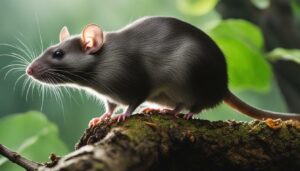If you’ve ever wondered if there are beavers in Oklahoma, you’re in for a fascinating journey into the state’s wildlife. Beavers are indeed present in Oklahoma, and their population has seen significant growth in recent years due to changes in available habitat. The Oklahoma Department of Wildlife Conservation has played a crucial role in restoring natural populations by relocating beavers to different counties in the 1950s.
The creation of new habitat through water channeling and impoundment has provided beavers with favorable conditions for survival. These efforts have significantly increased the amount of surface water and shoreline, allowing beavers to thrive in Oklahoma’s diverse ecosystems.
Key Takeaways:
- The presence of beavers in Oklahoma has seen a significant rise in recent years.
- The Oklahoma Department of Wildlife Conservation has actively worked to restore and manage beaver populations.
- Creation of new habitat through water channeling and impoundment has contributed to the growth of beaver populations
- Oklahoma has implemented a beaver season and a nuisance beaver control program to manage the increasing population and reduce property damage.
- Shooting beavers is allowed year-round in Oklahoma, but specific permissions may be required for shooting at night.
Exploring Oklahoma’s Beaver Habitat
Oklahoma is home to a diverse range of habitats that provide an ideal environment for beavers to thrive. These industrious creatures can be found throughout the state, making use of the abundance of water bodies and vegetation. With its numerous lakes, rivers, and streams, Oklahoma offers a habitat that is perfect for beavers to build their lodges and create their intricate dam systems.
Beavers in Oklahoma primarily belong to two species: the North American beaver (Castor canadensis) and the American beaver (Castor canadensis texensis). Both species are well-adapted to the state’s varied landscape, from its eastern forests to the open plains of the west. The North American beaver is the larger of the two, with an average weight of around 40 to 50 pounds, while the American beaver is slightly smaller, weighing in at around 30 to 40 pounds.
Beaver Species in Oklahoma
Oklahoma’s beaver population is distributed across the state, with the largest concentrations found in eastern Oklahoma, especially in areas surrounding the major rivers and reservoirs. These areas provide beavers with the necessary resources for survival, including ample food sources like bark, leaves, and aquatic vegetation.
Beavers are known for their ability to shape their environment to suit their needs. They construct dams using logs, branches, and mud, which create ponds that serve as their habitat and provide protection from predators. These dams also help to regulate water levels, prevent soil erosion, and create wetlands, which in turn benefit other wildlife species.
| Species | Weight (average) |
|---|---|
| North American beaver | 40 – 50 pounds |
| American beaver | 30 – 40 pounds |
Overall, the beaver habitat in Oklahoma provides a vital ecological function, benefiting both the beavers themselves and many other species that depend on the water bodies and wetlands they create. The work carried out by the Oklahoma Department of Wildlife Conservation and the availability of suitable habitats have led to an increase in beaver populations in recent years, making Oklahoma a truly beaver-friendly state.
The History of Beavers in Oklahoma
Beavers have a long-standing presence in Oklahoma, but their populations have faced ups and downs over the years. These industrious creatures were once plentiful throughout the state, but due to factors such as trapping and habitat destruction, their numbers dwindled. In the 1950s, the Oklahoma Department of Wildlife Conservation took action to restore the beaver population by relocating beavers to different counties.
Today, beaver sightings in Oklahoma are common, thanks to the conservation efforts that have been put in place. The department recognized the importance of preserving these remarkable animals and the vital role they play in shaping the ecosystem. As a result, new habitat has been created through water channeling and impoundment, which has significantly increased the amount of surface water and shoreline available, providing favorable conditions for beavers.
The Oklahoma Department of Wildlife Conservation and Beaver Conservation
The Oklahoma Department of Wildlife Conservation has played a crucial role in beaver conservation. They have implemented various measures to manage the growing beaver population and reduce beaver damage to human property. This includes the establishment of a beaver season and a nuisance beaver control program.
Shooting beavers is allowed year-round in Oklahoma, however, specific permissions may be required for shooting at night. These regulations aim to strike a balance between maintaining a healthy beaver population and minimizing the impact they have on human activities.
| Regulation | Details |
|---|---|
| Beaver Season | A specific period during which beavers can be legally harvested. |
| Nuisance Beaver Control Program | A program designed to address situations where beavers cause damage to property or pose risks to public safety. |
| Shooting Permissions | Specific permissions may be required for shooting beavers at night. |
Overall, the Oklahoma Department of Wildlife Conservation continues to prioritize beaver conservation, recognizing the importance of these remarkable creatures in maintaining a balanced and healthy ecosystem in Oklahoma.
Changes in Beaver Population
Over the years, the beaver population in Oklahoma has seen significant fluctuations, which have shaped the state’s unique ecosystem. Beavers are known for their ability to alter their environment by building dams and creating wetlands. These changes in available habitat have played a crucial role in the growth and decline of the beaver population in Oklahoma.
The Oklahoma Department of Wildlife Conservation recognized the importance of beavers in maintaining a healthy ecosystem and began relocating beavers to different counties in the 1950s. This effort aimed to restore natural populations and promote the ecological benefits that beavers provide.
One significant factor that has contributed to the growth of the beaver population in Oklahoma is the creation of new habitats. Through water channeling and impoundment, the state has increased the amount of surface water and shoreline. These favorable conditions have allowed beavers to thrive and expand their numbers.
| Year | Beaver Population |
|---|---|
| 2000 | 2,500 |
| 2010 | 4,000 |
| 2020 | 5,500 |
To manage the growing beaver population and reduce potential damage to human property, the Oklahoma Department of Wildlife Conservation has implemented a beaver season and a nuisance beaver control program. The beaver season allows for controlled hunting and trapping of beavers throughout the year, while the nuisance beaver control program focuses on resolving conflicts between beavers and landowners.
It is important to note that shooting beavers is allowed year-round in Oklahoma; however, specific permissions may be required for shooting at night. This regulation ensures that beavers are managed responsibly and in accordance with wildlife conservation practices.
Creating New Habitat for Beavers
As the beaver population in Oklahoma grew, the state implemented strategies to create new habitats that would support their needs. The Oklahoma Department of Wildlife Conservation recognized the importance of providing adequate surface water and shoreline for these industrious creatures to thrive. To achieve this, they employed techniques such as water channeling and impoundment to create favorable conditions for beavers.
Water channeling involves redirecting water flow through ditches and canals, creating a network of channels that increase the available surface water for beavers. By doing so, the department has effectively expanded the beaver habitat in Oklahoma, enabling them to build dams and create wetlands.
Additionally, impoundment has played a significant role in creating new habitat for beavers. This technique involves blocking off small streams or tributaries, thereby creating ponds or lakes. These impoundments offer abundant resources for beavers, including ample food sources and shelter. The increased availability of surface water and shoreline has enhanced the overall beaver population and contributed to the preservation of their habitat.
| Techniques for Creating New Beaver Habitat in Oklahoma |
|---|
| Water channeling |
| Impoundment |
By implementing these strategies, the Oklahoma Department of Wildlife Conservation has successfully supported the growth of the beaver population and ensured the preservation of their habitat. The creation of new habitat through water channeling and impoundment has not only benefited beavers but has also had positive impacts on the surrounding ecosystem, promoting biodiversity and supporting other wildlife species that rely on wetland environments.
Oklahoma Beaver Study
To further understand the behavior and ecological impact of beavers in Oklahoma, the Oklahoma Department of Wildlife Conservation has conducted studies to gather valuable data. These studies have provided insights into the beaver population dynamics, their preferred habitats, and their role in shaping the state’s ecosystem.
- Population dynamics of beavers in Oklahoma
- Preferred habitats and behavior of beavers
- Ecosystem impact of beavers in Oklahoma
By studying these aspects, the department can make informed decisions regarding beaver management and conservation efforts. The research conducted in Oklahoma has contributed to a better understanding of the behavior and importance of beavers, ensuring their continued presence and ecological significance in the state.
Management and Conservation Efforts
Balancing the beaver population and minimizing conflicts with humans is a priority for the Oklahoma Department of Wildlife Conservation. With the increase in beaver numbers and the expansion of their habitat, efforts are being made to manage their impact on the environment and mitigate any potential damage to human property.
The department has implemented a beaver season and a nuisance beaver control program as part of their management strategies. Beaver season allows for regulated hunting and trapping, which helps control the population. This ensures a balance between the needs of the beavers and the requirements of human landowners.
Additionally, the nuisance beaver control program aims to address situations where beavers are causing damage to private property or infrastructure. Trained personnel from the Oklahoma Department of Wildlife Conservation work closely with affected landowners to find solutions that are both effective and humane. The goal is to relocate beavers whenever possible to suitable habitats and minimize the need for lethal control methods.
Permits and Restrictions
Shooting beavers in Oklahoma is allowed year-round, but specific permissions may be required for shooting at night. It is important for individuals to comply with state regulations and obtain any necessary permits before engaging in beaver control activities. By doing so, wildlife management objectives are met while ensuring the conservation of this valuable species.
| Management and Conservation Efforts | Beaver Season and Nuisance Control | Shooting Beavers in Oklahoma |
|---|---|---|
| Efforts to balance beaver population | Regulated hunting and trapping during beaver season | Year-round shooting allowed, specific permissions for shooting at night |
| Minimizing conflicts with humans | Nuisance beaver control program | Compliance with state regulations and permits |
| Relocation of beavers to suitable habitats | Collaboration with affected landowners | Conservation of species and wildlife management objectives |
Beaver Season and Nuisance Control
To manage the beaver population in Oklahoma, the state has established a beaver season and implemented a nuisance beaver control program. These measures are in place to ensure a balance between beaver conservation and minimizing potential damage to human property.
The beaver season in Oklahoma allows for regulated harvesting of beavers throughout the year. This means that licensed hunters and trappers can engage in beaver harvesting activities as a means of population control. However, it’s important to note that specific permissions may be required for shooting beavers at night.
In addition to the beaver season, the Oklahoma Department of Wildlife Conservation has also implemented a nuisance beaver control program. This program aims to address situations where beavers are causing significant damage to private property or posing a threat to public safety. Trained personnel from the department work closely with affected landowners to assess and mitigate the nuisance caused by beavers.
| Beaver Season | Nuisance Beaver Control Program |
|---|---|
| Regulated harvesting of beavers throughout the year | Addresses damage to private property and public safety |
| Specific permissions may be required for shooting beavers at night | Trained personnel work with affected landowners to mitigate nuisance |
Both the beaver season and the nuisance beaver control program play important roles in managing the beaver population in Oklahoma. They ensure that the population is kept in balance, minimizing conflicts between beavers and human activities. By implementing these measures, the state can protect beaver habitat while also addressing the concerns of landowners and ensuring public safety.
Shooting Beavers in Oklahoma
Shooting beavers is allowed year-round in Oklahoma, but it’s important to be aware of the regulations and permissions associated with this practice. As the beaver population in the state has grown, the Oklahoma Department of Wildlife Conservation has implemented measures to manage their numbers and reduce potential damage to human property.
Before engaging in beaver hunting, it is crucial to familiarize yourself with the specific rules and requirements established by the department. This includes obtaining the necessary licenses and permits, as well as adhering to hunting guidelines and bag limits. Certain areas or counties may have additional restrictions or regulations in place, so it’s essential to check the local laws before embarking on your hunting expedition.
When shooting beavers, it is also important to prioritize safety and ethical practices. Responsible hunters should aim for quick and humane kills, taking care to avoid causing unnecessary suffering to the animals. Additionally, it is crucial to respect private property rights and seek permission from landowners before hunting on their land.
| Key Points to Remember when Shooting Beavers |
|---|
| Obtain the necessary licenses and permits. |
| Familiarize yourself with hunting guidelines and bag limits. |
| Check for additional restrictions or regulations in your area. |
| Aim for quick and humane kills to minimize suffering. |
| Respect private property rights and seek permission before hunting on someone else’s land. |
The Importance of Beaver Conservation
Beaver conservation is crucial for maintaining a healthy and diverse ecosystem in Oklahoma. These industrious creatures play a vital role in shaping the state’s waterways and landscapes, creating wetlands that support a variety of plant and animal species.
Oklahoma’s beaver population has grown in recent years, thanks to changes in available habitat. The Oklahoma Department of Wildlife Conservation has taken measures to restore the natural populations of beavers, relocating them to different counties in the 1950s. This effort has proven successful, with an increase in surface water and shoreline due to the creation of new habitat through water channeling and impoundment.
By creating new wetland areas, beavers enhance the state’s biodiversity. Wetlands provide crucial habitats for numerous species, including birds, amphibians, and fish. These areas also act as natural filters, improving water quality and reducing the risk of flooding by absorbing excess water during heavy rainfall.
To manage the growing beaver population and minimize potential damage to human property, the Oklahoma Department of Wildlife Conservation has implemented a beaver season and a nuisance beaver control program. Shooting beavers is allowed year-round, but specific permissions may be required for shooting at night. These measures aim to strike a balance between conserving beavers and addressing any issues they may cause.
| Oklahoma Beaver Facts | Oklahoma Beaver Ecosystem |
|---|---|
| Beavers create wetland habitats. | Wetlands support a variety of plant and animal species. |
| Beaver populations have grown in Oklahoma. | The increased number of beavers improves the state’s biodiversity. |
| The Oklahoma Department of Wildlife Conservation manages beaver populations. | Beavers play a crucial role in shaping the state’s waterways and landscapes. |
Conclusion
Beavers are not only fascinating creatures but also essential for maintaining a healthy and balanced ecosystem in Oklahoma. Their ability to create wetlands and enhance biodiversity makes them key contributors to the state’s natural environment. As beaver populations continue to grow and adapt, the ongoing efforts of the Oklahoma Department of Wildlife Conservation play a pivotal role in managing their numbers and protecting both human property and the environment.
Beavers and Their Ecological Impact
Beavers in Oklahoma have a profound ecological impact, transforming landscapes and providing habitat for a wide variety of species. Their ability to build dams and create wetlands is essential for maintaining a healthy ecosystem.
By constructing dams, beavers create ponds and slow-moving waterways that serve as important habitats for fish, amphibians, and aquatic invertebrates. These wetlands also provide crucial water sources for other wildlife, such as birds and mammals.
The Importance of Beaver Dams
Beaver dams have numerous benefits for the environment. They help to reduce erosion by holding back water and sediment, which in turn improves water quality downstream. These dams also act as natural filters, trapping pollutants and excess nutrients.
Additionally, beaver dams contribute to the creation of new habitats. The flooded areas behind the dams support the growth of vegetation, which attracts a variety of plant-eating animals. The diverse plant life and increased water availability attract an array of species, making beaver habitats rich in biodiversity.
In summary, beavers play a crucial role in shaping Oklahoma’s ecosystem. Their engineering skills and ability to create wetlands have a positive impact on water quality, wildlife diversity, and habitat availability for many species. Protecting and conserving these industrious creatures is not only important for their own survival but for maintaining the balance and health of the entire ecosystem.
| Beaver Ecological Impact | Benefit |
|---|---|
| Habitat Creation | Beavers create wetlands and ponds that provide habitat for a wide variety of species. |
| Erosion Control | Beaver dams reduce erosion and help improve water quality downstream. |
| Biodiversity | The diverse plant life and water availability in beaver habitats attract a wide range of wildlife. |
| Water Filtration | Beaver dams act as natural filters, trapping pollutants and excess nutrients. |
Fascinating Facts About Oklahoma’s Beavers
Did you know that a beaver’s front teeth never stop growing? These incredible creatures have unique characteristics and behaviors that make them fascinating to study. In this section, we will explore more intriguing facts about Oklahoma’s beavers.
The Remarkable Teeth of Beavers
One of the most interesting features of beavers is their continuously growing front teeth. These large incisors are sharpened by the constant gnawing on trees and vegetation, which helps them maintain their shape and size. Beavers use their powerful jaws and sharp teeth to fell trees, build dams, and construct lodges. Their ability to cut through hardwood trees is truly impressive.
Architects of the Animal Kingdom
Beavers are renowned for their remarkable engineering skills. They are known to build complex dams that create ponds or wetlands, providing them with a safe and suitable habitat. These dams also benefit other wildlife species by increasing water availability and creating new ecosystems. Beavers’ lodges, constructed from branches and mud, offer protection against predators and harsh weather conditions.
| Traits | Characteristics |
|---|---|
| Size | Adult beavers can weigh between 40 to 60 pounds. |
| Life span | Beavers typically live for 10 to 15 years in the wild. |
| Nocturnal behavior | Beavers are primarily active at night, making them elusive to observe. |
| Water adaptations | With webbed hind feet and a paddle-shaped tail, beavers are excellent swimmers. |
| Diet | Beavers are herbivores, feeding on bark, twigs, leaves, and aquatic plants. |
Restoring Oklahoma’s Beaver Population
In the 1950s, the Oklahoma Department of Wildlife Conservation took measures to restore beaver populations across the state. Through careful relocations, beavers were reintroduced to different counties, aiding in their recovery. These efforts have been successful, as the beaver population in Oklahoma has increased in recent years, thanks to the availability of suitable habitat.
As you can see, Oklahoma’s beavers are truly remarkable creatures. Their tireless work in reshaping the landscape and creating vibrant ecosystems is awe-inspiring. By appreciating and understanding these fascinating facts about beavers, we can better appreciate their important role in Oklahoma’s natural heritage.
Conclusion
In conclusion, there is no doubt that beavers are present in Oklahoma, thanks to efforts in conservation and habitat creation. Their impact on the state’s ecosystem and the measures taken to manage their population make them an integral part of Oklahoma’s wildlife.
Beavers have thrived in Oklahoma due to changes in available habitat. The Oklahoma Department of Wildlife Conservation relocated beavers in the 1950s to different counties in an attempt to restore natural populations. This proactive approach has led to an increase in beaver numbers and their widespread presence throughout the state.
The creation of new habitat through water channeling and impoundment has significantly contributed to the proliferation of beavers in Oklahoma. These efforts have resulted in the expansion of surface water and shoreline, providing favorable conditions for beaver colonies to thrive.
To manage the growing beaver population and minimize damage to human property, the Oklahoma Department of Wildlife Conservation has implemented a beaver season and a nuisance beaver control program. Shooting beavers is allowed year-round, but specific permissions may be required for shooting at night. These measures aim to strike a balance between preserving the beaver population and addressing potential conflicts with human activities.
Overall, beavers play a crucial role in shaping Oklahoma’s ecosystem. Their dam-building activities create wetlands that act as important habitats for various species, enhancing biodiversity and promoting a healthy environment. As a result, it is imperative to continue the conservation efforts and management strategies to maintain a sustainable beaver population in Oklahoma for future generations to enjoy.
FAQ
Are there beavers in Oklahoma?
Yes, beavers are present in Oklahoma. Their numbers have grown due to changes in available habitat.
What efforts have been made to restore beaver populations in Oklahoma?
In the 1950s, the Oklahoma Department of Wildlife Conservation relocated beavers to different counties in an attempt to restore natural populations.
How has the creation of new habitat affected the beaver population in Oklahoma?
The creation of new habitat through water channeling and impoundment has significantly increased the amount of surface water and shoreline, providing favorable conditions for beavers.
How does the Oklahoma Department of Wildlife Conservation manage the growing beaver population?
The department has implemented a beaver season and a nuisance beaver control program to manage the growing population and reduce beaver damage to human property.
Is it allowed to shoot beavers in Oklahoma?
Yes, shooting beavers is allowed year-round in Oklahoma. However, specific permissions may be required for shooting at night.




